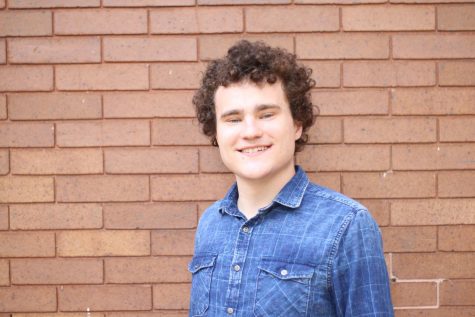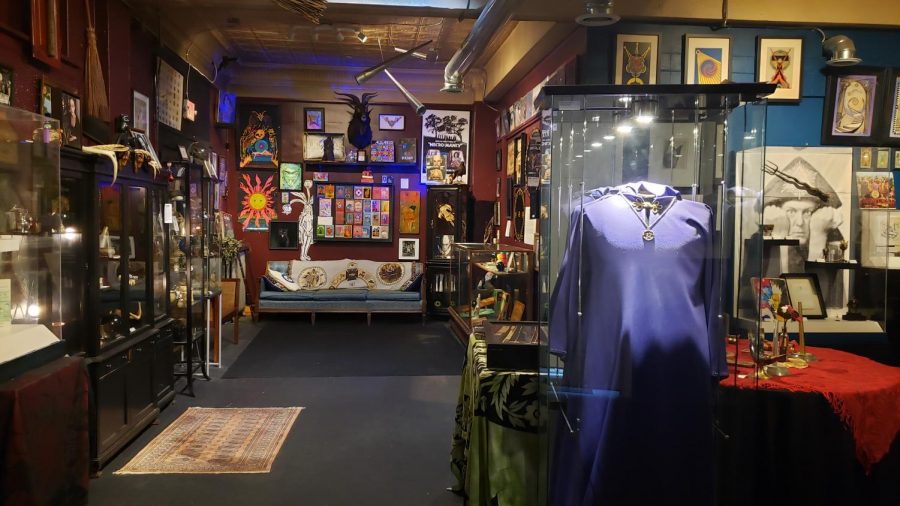The Buckland Museum of Witchcraft, home to trapped demons and Wiccan history
Courtesy of Buckland Museum of Witchcraft and Magick
The Buckland Museum of Witchcraft and Magick began as the private collection of Raymond Buckland, the founder of American Wicca whose robe is pictured here.
Steven Intermill seemed like he could be an extra on “The Drew Carey Show,” with his greying hair, faded blue jeans and soft-spoken personality. He is the type of person who finds cleaning meditative.
Then, he grabbed a metal axe.
“You don’t want to have this around during your rituals because you don’t want to lose a toe or something worse.”
“Instead you use something like that,” said Intermill gesturing towards a much safer tinfoil axe in a display case.
Intermill is the chief curator of the Buckland Museum of Witchcraft and Magick in Old Brooklyn, a neighborhood in Cleveland. While sweeping the floor the day after a puppet show on Ancient Egypt, he moved past countless artifacts, from Ouija boards to wands.
“I love it when witches of any sort come in here and see a bit their cultural heritage,” said Intermill. “That’s really one of the key pieces of this. I daydream of making this the Vatican museum of the occult.”
The museum started in 1966 as Raymond Buckland’s private collection when he ran a coven in Long Island, New York. The archives were originally displayed in his basement. Shortly after starting the coven, however, someone set his car on fire. The founder of American Wicca decided to open the collection up to the public.
“You’re probably not going to set someone’s car on fire if you can go and talk to them,” said Intermill.
The collection stopped in New Hampshire and New Orleans before coming to Ohio. Toni Rotonda acquired the collection from Buckland when it was part of the Columbus-based coven the Temple of Sacrifice, and moved the collection to Cleveland after speaking with Intermill. Rotonda is the owner of the actual artifacts, while Intermill runs the museum.
“Ray was a very kind and funny man,” said Rotonda. “When he spoke, everyone listened. We listened because we always knew that there would be a joke or funny ending that would leave us all in tears of laughter. I miss him.”
Wicca has its basis in western pre-Christian pagan rituals. Wicca has grown tremendously since an angry neighbor set Buckland’s car on fire, and in 1986 was recognized as an official religion by the U.S. Government. Wicca, Intermill said, is incredibly customizable and taylor-made for individual practice, leading to many different branches and philosophies.
“If you talk to five Wiccans, you’ll get six definitions of what Wicca is,” said Intermill.
Intermill said the museum’s founder viewed Wicca as a way to have a closer, more personal connection to the divine.
Inside the red-brick building Intermill admired his most prized piece, the headdress of the first high priestess of American Wicca. It is a modest metal crown with a half-moon on top. He called it the centerpiece of the museum, the place from where the energy of the building radiates. The exhibit also displays an important aspect of Wicca: parity between men and women as both clergy members and deities.
“Wiccans believe in a God and Goddess,” said Intermill. “They are equal, but the Goddess gets a bit more attention because God is talked about a lot somewhere else.”
Next to the crown, the museum’s most valuable artifact is it’s most teachable: a ceremonial helmet Buckland made for a Halloween ritual. It resembles a Viking helmet: a silver sphere in the middle with horns on the side, yet it has its origins in a shopping spree rather than ancient history.
“He goes to a local hardware store, grabs a pile of mixing bowls, puts one on his head and says ‘hey this fits,’” said Intermill. “Then he goes to the toy aisle gets some old Davy Crockett toy sets and here we see a beautiful expression of the craft. You can’t just buy something like this at J.C. Penny—you have to put your own energy into it.”
To the side of the mixing bowl helmet are three books. One is the original English manuscript of Buckland’s “Complete Book of Witchcraft” on a notebook that cost less than two dollars. Next to his draft, there is a professional printing of it, complete with its now-iconic blue cover, and a Japanese translation of one of Buckland’s other books.
In front of the late 60s concert advertisements for the Fillmore East and West, is an ancient artifact that required craftsmanship without the benefit of hardware stores: a 200-year-old Mandrake root carved to look like a mother and son. The root would have been used to try to solve fertility issues.
“Let’s face it, most of the stuff we have here was used in 20th-century ritual,” said Intermill. This is something that goes back to the cunning woman on the edge of town you don’t pay attention to but when you need something you go see her. You would say ‘hey, I have this problem my wife’s not having kids, and she would do her magic.’”
Though they are often intertwined, Wicca is different from Satanism. Since it is based on pre-Christian faiths, witches don’t even believe in the devil or the concept of heaven or hell. The two are frequently confused since both use the pentagram, though Satanists use an inverted pentagram in contrast to pagans, who use the symbol right side up. Still, there are artifacts from Anton LaVey, the founder of the Church of Satan, at the Buckland museum, since many patrons are also interested in satanic ideas. However, what the two religions do have in common is a similar time period, and both offer alternatives to mainstream Abrahamic religions.
Wicca gained much of its traction during the counterculture, growing alongside other new American religions and new age spirituality. The Starwood Festival, one of the largest neo-pagan festivals in the United States, takes place outside of Cleveland in July. Pamphlets were passed out and hung up on telephone polls after the Hessler Street Fair, the ground zero for the Cleveland Counterculture.
Though both focus on intuition and a connection with nature, there are large differences between hippie new age spirituality and Wicca. The hippie psychedelic spirituality of the 1960s inspired by Aldous Huxley, the author of “Brave New World,” and Timothy Leary, is influenced mainly by Eastern philosophies, like Hinduism and Zen Buddhism. Paganism, by contrast, focuses mainly on European traditions. New-age spirituality often, in the words of Hunter S. Thompson, sold the idea that one could “buy Peace and Understanding for three bucks a hit,” through the use of psychedelic drugs like LSD. Wicca emphasizes ritualistic practice, with the use of altars, prayer circles, relics and other tools meant to enhance one’s energy.
However, the progressive, anti-establishment politics of both movements make them natural allies, as evidenced by the counterculture concert posters and a ticket stub from a Leary speech in Cleveland on display at Buckland.
“Witchcraft is at its core a political and a feminist movement,” said Intermill. “It would be difficult to be a witch and not be a feminist.”
Of course, defending against evil spirits is important, too.
“People always want to see the demon in a box,” said a dejected Intermill. “People are always coming in like let me see the demon in a box.”
Intermill walks past the Ouija boards to an ominous glass case in front of a copy of The Beatles’ “Sgt. Pepper’s Lonely Hearts Club Band” (the cover features Crowley). An illustration of a demon stands above a box tied up with string and surrounded by salt.
Here is the demon in a box. Open at your own risk.
Buckland himself captured this spirit when a friend of his in New York was having demon trouble and asked for his services. Intermill keeps it shut to make sure the museum doesn’t acquire any more bad mojo.
Intermill once had to free The Christmas Story house from a dryness not caused by a demonic presence, but a human one, a lack of care. The man in charge of preserving the works of the occult once ran a tribute to a cherished children’s movie.
“[The Christmas Story House] was very grey and kind of blah,” said Intermill. “So, I installed LED lights, wrote descriptions of things. It was a great experience I learned how to operate a museum and how to display things properly.”
Now Intermill is celebrating a different holiday inspired by paganism. Halloween is based on a pagan holiday, Samhain, and is equivalent to the Wiccan New Year. To honor the occasion, Intermill waters the plants he has on display in the window potted in classic Garfield-orange trick-or-treat pumpkin baskets.
“It’s supposed to be the time when the veil is the thinnest between the living and the dead,” said Intermill. “Samhain was the time when people would dress up as monsters to scare away demons from the other side that may or may not want to do us harm.”
Today, Buckland has a special exhibit of William Mortensen’s photos of witches. Mortensen, who legendary landscape photographer Ansel Adams called the “anti-Christ,” was an early adopter of photo manipulation, using razor blades to create eerie images.
In front of Mortensen’s work, on display until Nov. 3, is an incomplete summoning circle with a pentagram inside. The circle is not incomplete because of a lack of funding or an artist leaving at the last minute. Instead, it’s unfinished so witches don’t try to turn the museum into a makeshift coven during business hours, something that has been a problem in the past.
“I don’t want to be in the gift shop and smell sulfur,” said Intermill. “Or see someone with their hood, a skull and a candle, start chanting Latin.”
“We have enough spirits around here already.”
The Buckland Museum of Witchcraft and Magick will be open from Tuesday to Friday from 12-7 p.m., Saturday 12-8 p.m. and Sunday 12-4 p.m., in celebration of Samhain. After Nov. 5, the museum will return to its normal operating hours of 12-7 p.m. from Tuesday to Saturday. Admission is $7 for adults, $6 for seniors over 60 and $5 for kids between three and 12 years old.

Matt Hooke, The Observer’s executive editor, is a fourth-year student studying English. This is his first year as executive editor after spending time...


